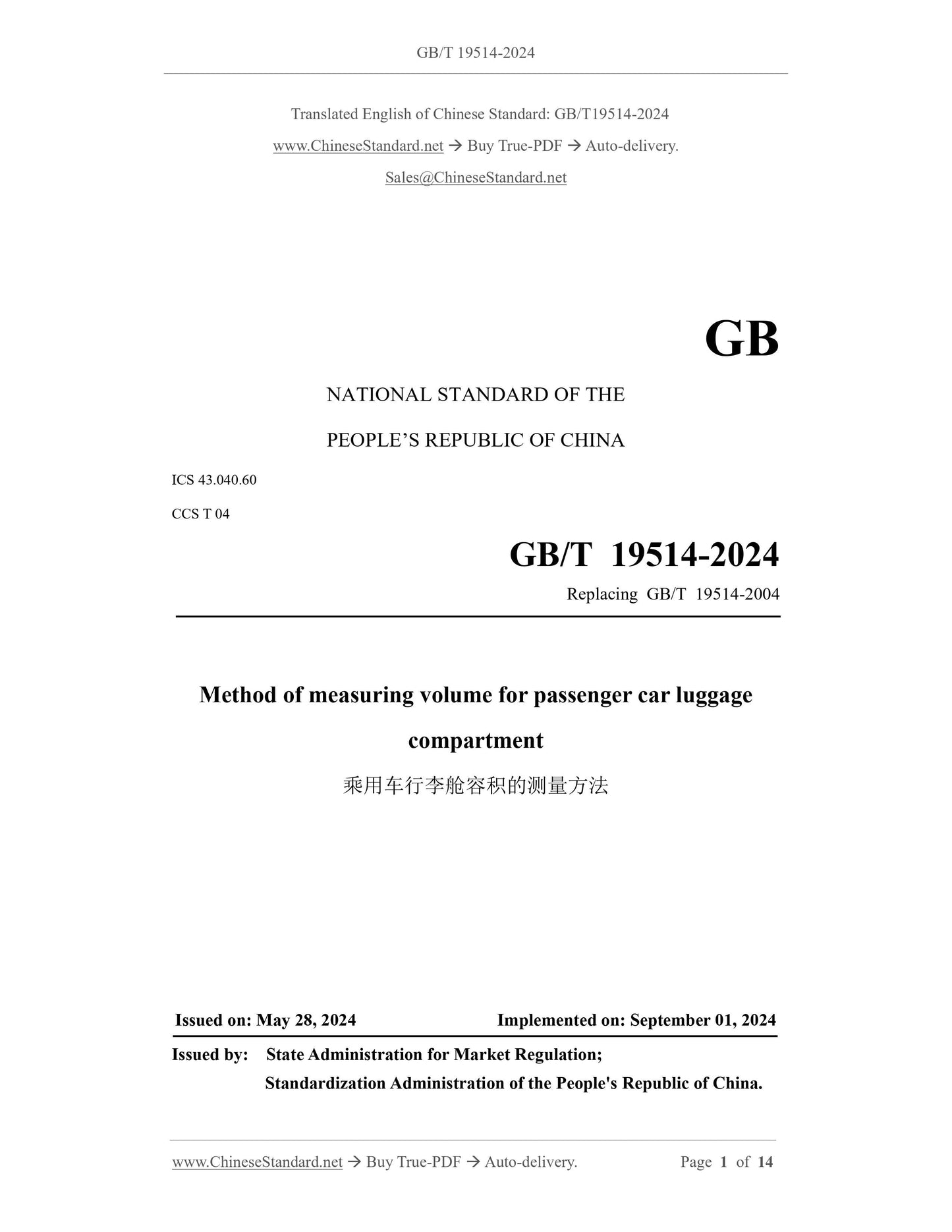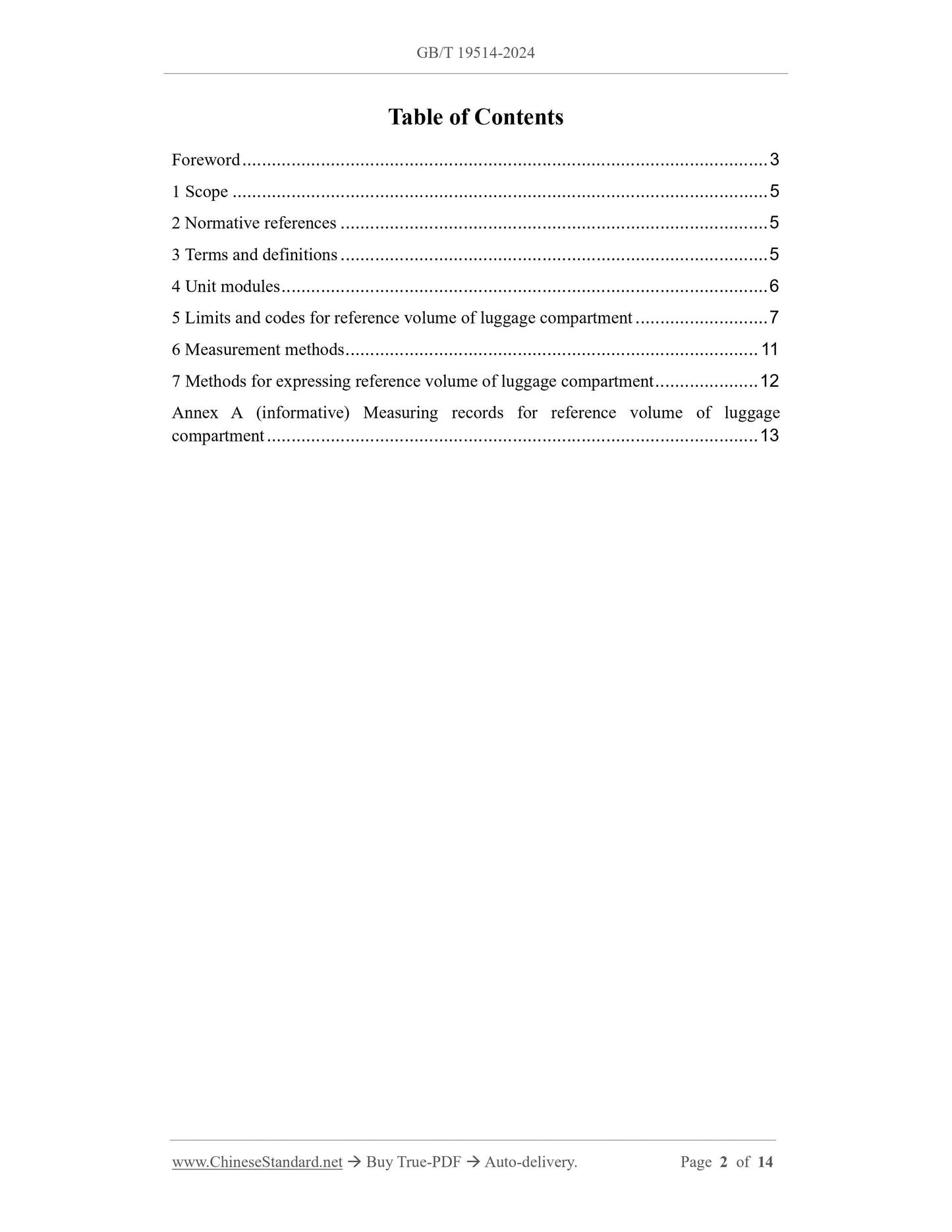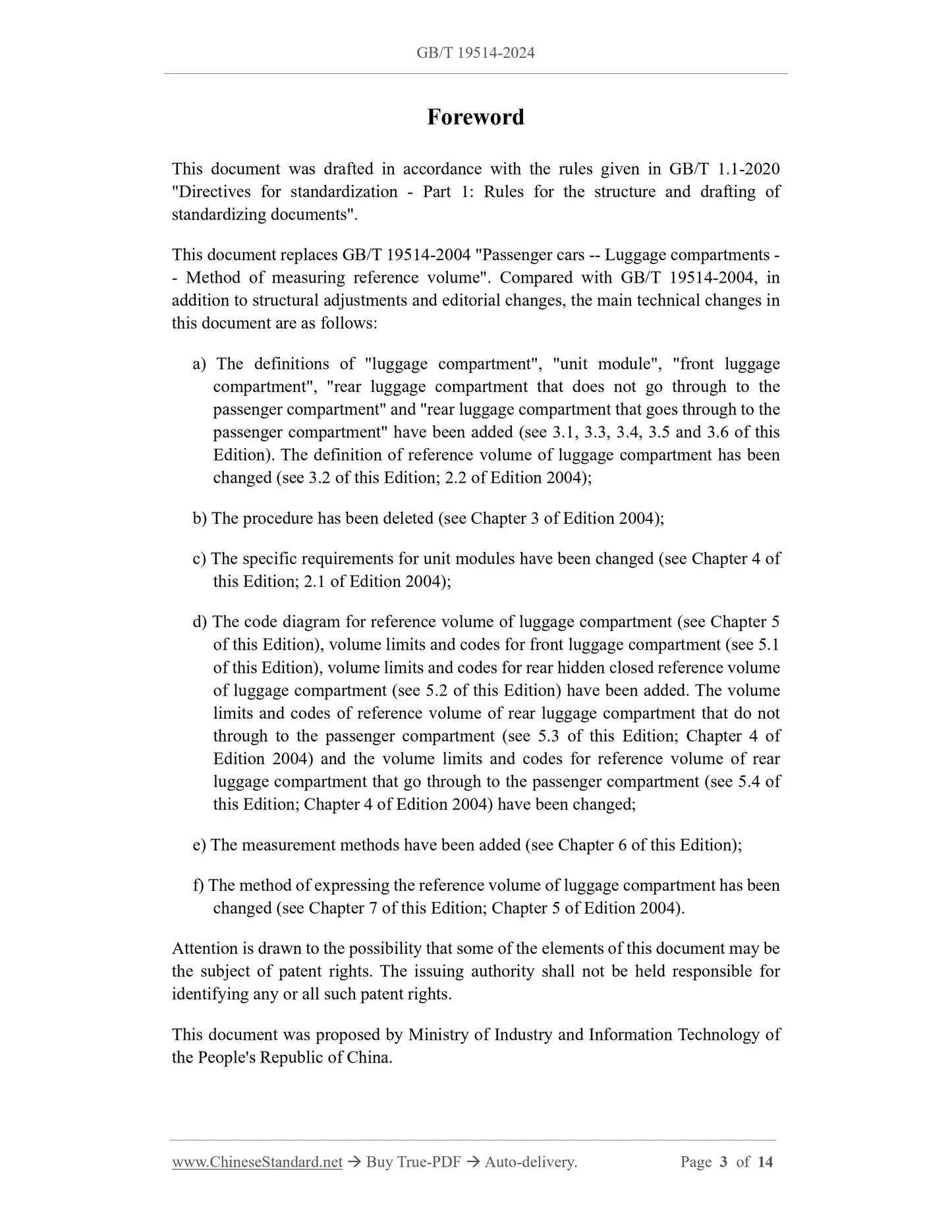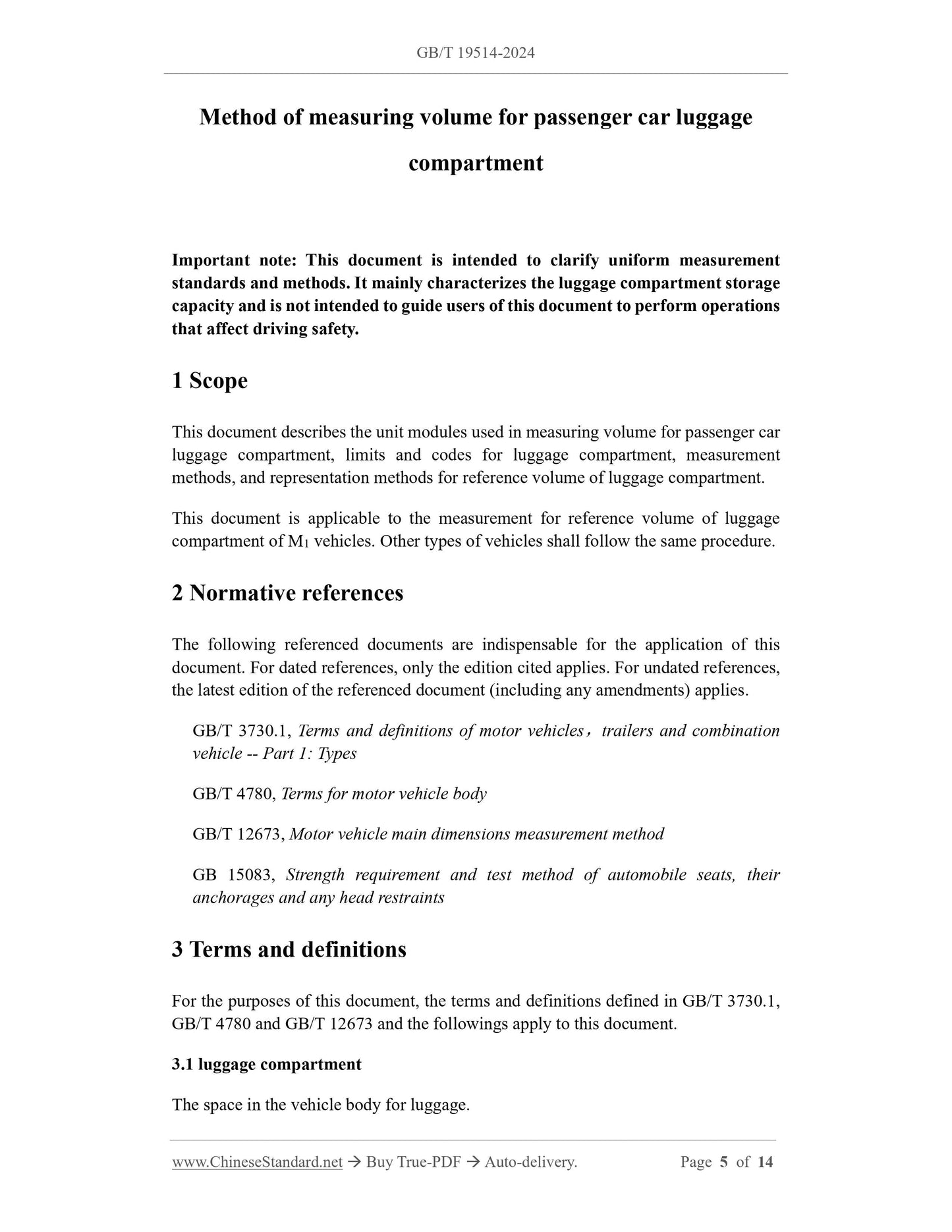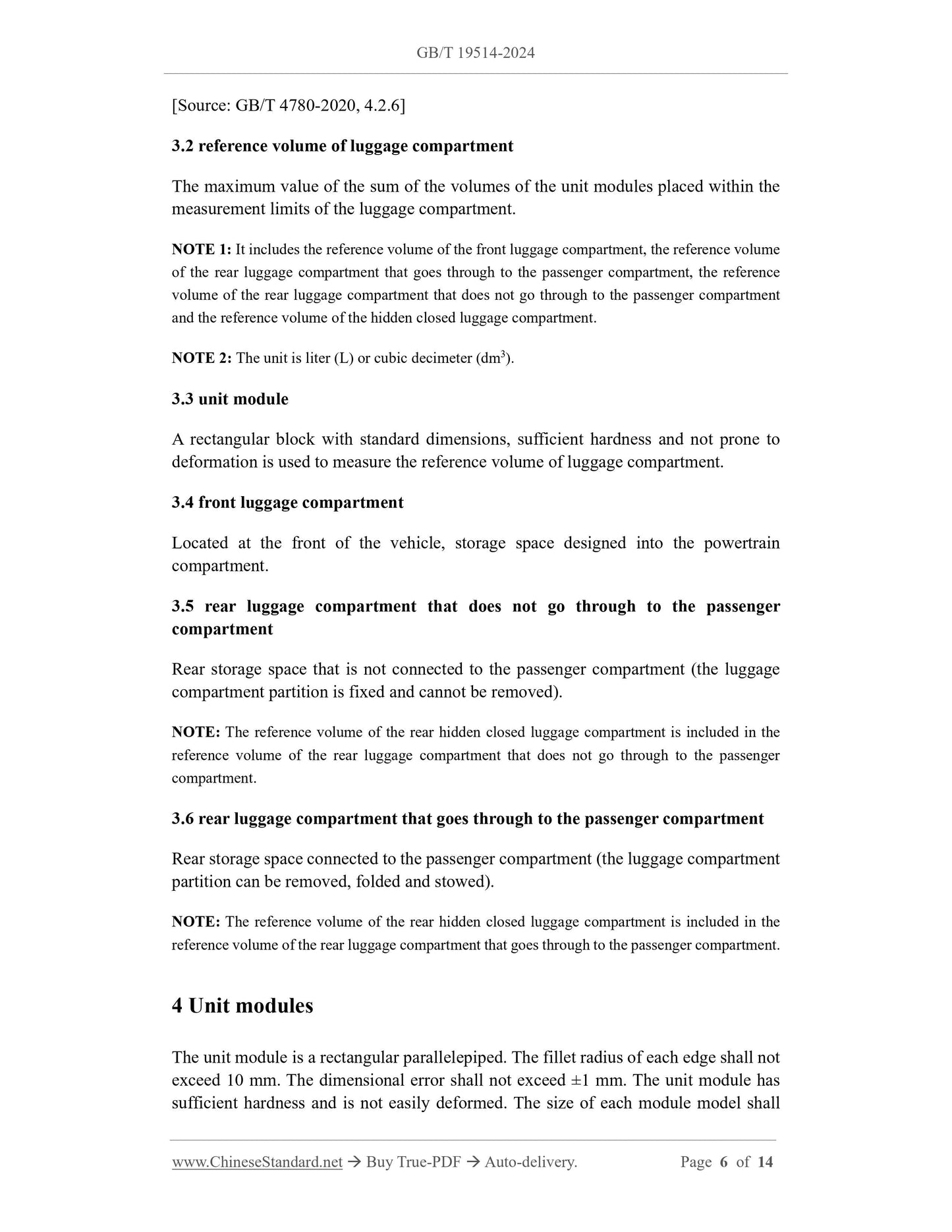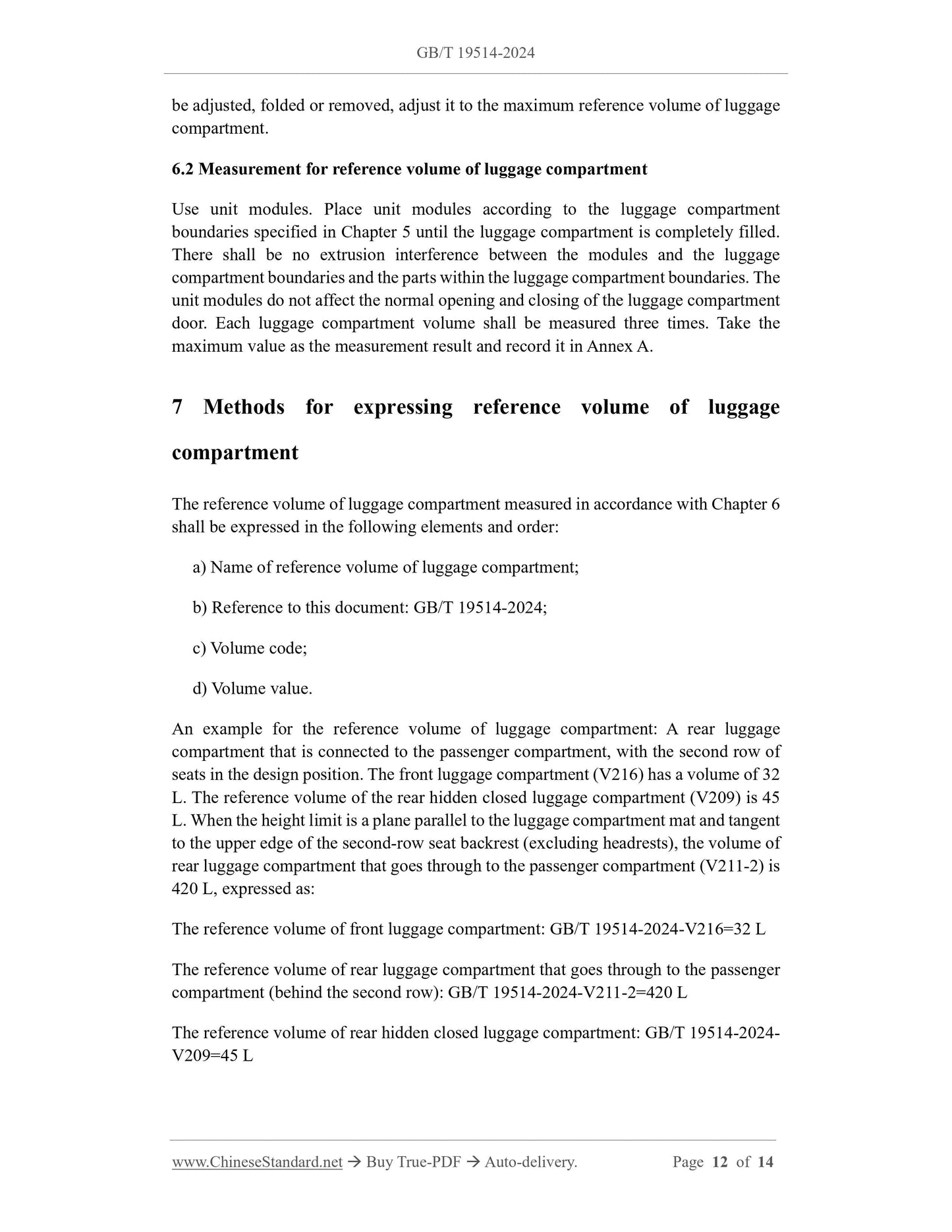1
/
of
6
www.ChineseStandard.us -- Field Test Asia Pte. Ltd.
GB/T 19514-2024 English PDF (GB/T19514-2024)
GB/T 19514-2024 English PDF (GB/T19514-2024)
Regular price
$245.00
Regular price
Sale price
$245.00
Unit price
/
per
Shipping calculated at checkout.
Couldn't load pickup availability
GB/T 19514-2024: Method of measuring volume for passenger car luggage compartment
Delivery: 9 seconds. Download (& Email) true-PDF + Invoice.
Get Quotation: Click GB/T 19514-2024 (Self-service in 1-minute)
Historical versions (Master-website): GB/T 19514-2024
Preview True-PDF (Reload/Scroll-down if blank)
GB/T 19514-2024
GB
NATIONAL STANDARD OF THE
PEOPLE’S REPUBLIC OF CHINA
ICS 43.040.60
CCS T 04
Replacing GB/T 19514-2004
Method of measuring volume for passenger car luggage
compartment
ISSUED ON: MAY 28, 2024
IMPLEMENTED ON: SEPTEMBER 01, 2024
Issued by: State Administration for Market Regulation;
Standardization Administration of the People's Republic of China.
Table of Contents
Foreword ... 3
1 Scope ... 5
2 Normative references ... 5
3 Terms and definitions ... 5
4 Unit modules ... 6
5 Limits and codes for reference volume of luggage compartment ... 7
6 Measurement methods ... 11
7 Methods for expressing reference volume of luggage compartment ... 12
Annex A (informative) Measuring records for reference volume of luggage
compartment ... 13
Foreword
This document was drafted in accordance with the rules given in GB/T 1.1-2020
"Directives for standardization - Part 1: Rules for the structure and drafting of
standardizing documents".
This document replaces GB/T 19514-2004 "Passenger cars -- Luggage compartments -
- Method of measuring reference volume". Compared with GB/T 19514-2004, in
addition to structural adjustments and editorial changes, the main technical changes in
this document are as follows:
a) The definitions of "luggage compartment", "unit module", "front luggage
compartment", "rear luggage compartment that does not go through to the
passenger compartment" and "rear luggage compartment that goes through to the
passenger compartment" have been added (see 3.1, 3.3, 3.4, 3.5 and 3.6 of this
Edition). The definition of reference volume of luggage compartment has been
changed (see 3.2 of this Edition; 2.2 of Edition 2004);
b) The procedure has been deleted (see Chapter 3 of Edition 2004);
c) The specific requirements for unit modules have been changed (see Chapter 4 of
this Edition; 2.1 of Edition 2004);
d) The code diagram for reference volume of luggage compartment (see Chapter 5
of this Edition), volume limits and codes for front luggage compartment (see 5.1
of this Edition), volume limits and codes for rear hidden closed reference volume
of luggage compartment (see 5.2 of this Edition) have been added. The volume
limits and codes of reference volume of rear luggage compartment that do not
through to the passenger compartment (see 5.3 of this Edition; Chapter 4 of
Edition 2004) and the volume limits and codes for reference volume of rear
luggage compartment that go through to the passenger compartment (see 5.4 of
this Edition; Chapter 4 of Edition 2004) have been changed;
e) The measurement methods have been added (see Chapter 6 of this Edition);
f) The method of expressing the reference volume of luggage compartment has been
changed (see Chapter 7 of this Edition; Chapter 5 of Edition 2004).
Attention is drawn to the possibility that some of the elements of this document may be
the subject of patent rights. The issuing authority shall not be held responsible for
identifying any or all such patent rights.
This document was proposed by Ministry of Industry and Information Technology of
the People's Republic of China.
Method of measuring volume for passenger car luggage
compartment
Important note: This document is intended to clarify uniform measurement
standards and methods. It mainly characterizes the luggage compartment storage
capacity and is not intended to guide users of this document to perform operations
that affect driving safety.
1 Scope
This document describes the unit modules used in measuring volume for passenger car
luggage compartment, limits and codes for luggage compartment, measurement
methods, and representation methods for reference volume of luggage compartment.
This document is applicable to the measurement for reference volume of luggage
compartment of M1 vehicles. Other types of vehicles shall follow the same procedure.
2 Normative references
The following referenced documents are indispensable for the application of this
document. For dated references, only the edition cited applies. For undated references,
the latest edition of the referenced document (including any amendments) applies.
GB/T 3730.1, Terms and definitions of motor vehicles, trailers and combination
vehicle -- Part 1: Types
GB/T 4780, Terms for motor vehicle body
GB/T 12673, Motor vehicle main dimensions measurement method
GB 15083, Strength requirement and test method of automobile seats, their
anchorages and any head restraints
3 Terms and definitions
For the purposes of this document, the terms and definitions defined in GB/T 3730.1,
GB/T 4780 and GB/T 12673 and the followings apply to this document.
3.1 luggage compartment
The space in the vehicle body for luggage.
[Source: GB/T 4780-2020, 4.2.6]
3.2 reference volume of luggage compartment
The maximum value of the sum of the volumes of the unit modules placed within the
measurement limits of the luggage compartment.
NOTE 1: It includes the reference volume of the front luggage compartment, the reference volume
of the rear luggage compartment that goes through to the passenger compartment, the reference
volume of the rear luggage compartment that does not go through to the passenger compartment
and the reference volume of the hidden closed luggage compartment.
NOTE 2: The unit is liter (L) or cubic decimeter (dm3).
3.3 unit module
A rectangular block with standard dimensions, sufficient hardness and not prone to
deformation is used to measure the reference volume of luggage compartment.
3.4 front luggage compartment
Located at the front of the vehicle, storage space designed into the powertrain
compartment.
3.5 rear luggage compartment that does not go through to the passenger
compartment
Rear storage space that is not connected to the passenger compartment (the luggage
compartment partition is fixed and cannot be removed).
NOTE: The reference volume of the rear hidden closed luggage compartment is included in the
reference volume of the rear luggage compartment that does not go through to the passenger
compartment.
3.6 rear luggage compartment that goes through to the passenger compartment
Rear storage space connected to the passenger compartment (the luggage compartment
partition can be removed, folded and stowed).
NOTE: The reference volume of the rear hidden closed luggage compartment is included in the
reference volume of the rear luggage compartment that goes through to the passenger compartment.
4 Unit modules
The unit module is a rectangular parallelepiped. The fillet radius of each edge shall not
exceed 10 mm. The dimensional error shall not exceed ±1 mm. The unit module has
sufficient hardness and is not easily deformed. The size of each module model shall
be adjusted, folded or removed, adjust it to the maximum reference volume of luggage
compartment.
6.2 Measurement for reference volume of luggage compartment
Use unit modules. Place unit modules according to the luggage compartment
boundaries specified in Chapter 5 until the luggage compartment is completely filled.
There shall be no extrusion interference between the modules and the luggage
compartment boundaries and the parts within the luggage compartment boundaries. The
unit modules do not affect the normal opening and closing of the luggage compartment
door. Each luggage compartment volume shall be measured three times. Take the
maximum value as the measurement result and record it in Annex A.
7 Methods for expressing reference volume of luggage
compartment
The reference volume of luggage compartment measured in accordance with Chapter 6
shall be expressed in the following elements and order:
a) Name of reference volume of luggage compartment;
b) Reference to this document: GB/T 19514-2024;
c) Volume code;
d) Volume value.
An example for the reference volume of luggage compartment: A rear luggage
compartment that is connected to the passenger compartment, with the second row of
seats in the design position. The front luggage compartment (V216) has a volume of 32
L. The reference volume of the rear hidden closed luggage compartment (V209) is 45
L. When the height limit is a plane parallel to the luggage compartment mat and tangent
to the upper edge of the second-row seat backrest (excluding headrests), the volume of
rear luggage compartment that goes through to the passenger compartment (V211-2) is
420 L, expressed as:
The reference volume of front luggage compartment: GB/T 19514-2024-V216=32 L
The reference volume of rear luggage compartment that goes through to the passenger
compartment (behind the second row): GB/T 19514-2024-V211-2=420 L
The reference volume of rear hidden closed luggage compartment: GB/T 19514-2024-
V209=45 L
GB/T 19514-2024
GB
NATIONAL STANDARD OF THE
PEOPLE’S REPUBLIC OF CHINA
ICS 43.040.60
CCS T 04
Replacing GB/T 19514-2004
Method of measuring volume for passenger car luggage
compartment
ISSUED ON: MAY 28, 2024
IMPLEMENTED ON: SEPTEMBER 01, 2024
Issued by: State Administration for Market Regulation;
Standardization Administration of the People's Republic of China.
Table of Contents
Foreword ... 3
1 Scope ... 5
2 Normative references ... 5
3 Terms and definitions ... 5
4 Unit modules ... 6
5 Limits and codes for reference volume of luggage compartment ... 7
6 Measurement methods ... 11
7 Methods for expressing reference volume of luggage compartment ... 12
Annex A (informative) Measuring records for reference volume of luggage
compartment ... 13
Foreword
This document was drafted in accordance with the rules given in GB/T 1.1-2020
"Directives for standardization - Part 1: Rules for the structure and drafting of
standardizing documents".
This document replaces GB/T 19514-2004 "Passenger cars -- Luggage compartments -
- Method of measuring reference volume". Compared with GB/T 19514-2004, in
addition to structural adjustments and editorial changes, the main technical changes in
this document are as follows:
a) The definitions of "luggage compartment", "unit module", "front luggage
compartment", "rear luggage compartment that does not go through to the
passenger compartment" and "rear luggage compartment that goes through to the
passenger compartment" have been added (see 3.1, 3.3, 3.4, 3.5 and 3.6 of this
Edition). The definition of reference volume of luggage compartment has been
changed (see 3.2 of this Edition; 2.2 of Edition 2004);
b) The procedure has been deleted (see Chapter 3 of Edition 2004);
c) The specific requirements for unit modules have been changed (see Chapter 4 of
this Edition; 2.1 of Edition 2004);
d) The code diagram for reference volume of luggage compartment (see Chapter 5
of this Edition), volume limits and codes for front luggage compartment (see 5.1
of this Edition), volume limits and codes for rear hidden closed reference volume
of luggage compartment (see 5.2 of this Edition) have been added. The volume
limits and codes of reference volume of rear luggage compartment that do not
through to the passenger compartment (see 5.3 of this Edition; Chapter 4 of
Edition 2004) and the volume limits and codes for reference volume of rear
luggage compartment that go through to the passenger compartment (see 5.4 of
this Edition; Chapter 4 of Edition 2004) have been changed;
e) The measurement methods have been added (see Chapter 6 of this Edition);
f) The method of expressing the reference volume of luggage compartment has been
changed (see Chapter 7 of this Edition; Chapter 5 of Edition 2004).
Attention is drawn to the possibility that some of the elements of this document may be
the subject of patent rights. The issuing authority shall not be held responsible for
identifying any or all such patent rights.
This document was proposed by Ministry of Industry and Information Technology of
the People's Republic of China.
Method of measuring volume for passenger car luggage
compartment
Important note: This document is intended to clarify uniform measurement
standards and methods. It mainly characterizes the luggage compartment storage
capacity and is not intended to guide users of this document to perform operations
that affect driving safety.
1 Scope
This document describes the unit modules used in measuring volume for passenger car
luggage compartment, limits and codes for luggage compartment, measurement
methods, and representation methods for reference volume of luggage compartment.
This document is applicable to the measurement for reference volume of luggage
compartment of M1 vehicles. Other types of vehicles shall follow the same procedure.
2 Normative references
The following referenced documents are indispensable for the application of this
document. For dated references, only the edition cited applies. For undated references,
the latest edition of the referenced document (including any amendments) applies.
GB/T 3730.1, Terms and definitions of motor vehicles, trailers and combination
vehicle -- Part 1: Types
GB/T 4780, Terms for motor vehicle body
GB/T 12673, Motor vehicle main dimensions measurement method
GB 15083, Strength requirement and test method of automobile seats, their
anchorages and any head restraints
3 Terms and definitions
For the purposes of this document, the terms and definitions defined in GB/T 3730.1,
GB/T 4780 and GB/T 12673 and the followings apply to this document.
3.1 luggage compartment
The space in the vehicle body for luggage.
[Source: GB/T 4780-2020, 4.2.6]
3.2 reference volume of luggage compartment
The maximum value of the sum of the volumes of the unit modules placed within the
measurement limits of the luggage compartment.
NOTE 1: It includes the reference volume of the front luggage compartment, the reference volume
of the rear luggage compartment that goes through to the passenger compartment, the reference
volume of the rear luggage compartment that does not go through to the passenger compartment
and the reference volume of the hidden closed lug...
Delivery: 9 seconds. Download (& Email) true-PDF + Invoice.
Get Quotation: Click GB/T 19514-2024 (Self-service in 1-minute)
Historical versions (Master-website): GB/T 19514-2024
Preview True-PDF (Reload/Scroll-down if blank)
GB/T 19514-2024
GB
NATIONAL STANDARD OF THE
PEOPLE’S REPUBLIC OF CHINA
ICS 43.040.60
CCS T 04
Replacing GB/T 19514-2004
Method of measuring volume for passenger car luggage
compartment
ISSUED ON: MAY 28, 2024
IMPLEMENTED ON: SEPTEMBER 01, 2024
Issued by: State Administration for Market Regulation;
Standardization Administration of the People's Republic of China.
Table of Contents
Foreword ... 3
1 Scope ... 5
2 Normative references ... 5
3 Terms and definitions ... 5
4 Unit modules ... 6
5 Limits and codes for reference volume of luggage compartment ... 7
6 Measurement methods ... 11
7 Methods for expressing reference volume of luggage compartment ... 12
Annex A (informative) Measuring records for reference volume of luggage
compartment ... 13
Foreword
This document was drafted in accordance with the rules given in GB/T 1.1-2020
"Directives for standardization - Part 1: Rules for the structure and drafting of
standardizing documents".
This document replaces GB/T 19514-2004 "Passenger cars -- Luggage compartments -
- Method of measuring reference volume". Compared with GB/T 19514-2004, in
addition to structural adjustments and editorial changes, the main technical changes in
this document are as follows:
a) The definitions of "luggage compartment", "unit module", "front luggage
compartment", "rear luggage compartment that does not go through to the
passenger compartment" and "rear luggage compartment that goes through to the
passenger compartment" have been added (see 3.1, 3.3, 3.4, 3.5 and 3.6 of this
Edition). The definition of reference volume of luggage compartment has been
changed (see 3.2 of this Edition; 2.2 of Edition 2004);
b) The procedure has been deleted (see Chapter 3 of Edition 2004);
c) The specific requirements for unit modules have been changed (see Chapter 4 of
this Edition; 2.1 of Edition 2004);
d) The code diagram for reference volume of luggage compartment (see Chapter 5
of this Edition), volume limits and codes for front luggage compartment (see 5.1
of this Edition), volume limits and codes for rear hidden closed reference volume
of luggage compartment (see 5.2 of this Edition) have been added. The volume
limits and codes of reference volume of rear luggage compartment that do not
through to the passenger compartment (see 5.3 of this Edition; Chapter 4 of
Edition 2004) and the volume limits and codes for reference volume of rear
luggage compartment that go through to the passenger compartment (see 5.4 of
this Edition; Chapter 4 of Edition 2004) have been changed;
e) The measurement methods have been added (see Chapter 6 of this Edition);
f) The method of expressing the reference volume of luggage compartment has been
changed (see Chapter 7 of this Edition; Chapter 5 of Edition 2004).
Attention is drawn to the possibility that some of the elements of this document may be
the subject of patent rights. The issuing authority shall not be held responsible for
identifying any or all such patent rights.
This document was proposed by Ministry of Industry and Information Technology of
the People's Republic of China.
Method of measuring volume for passenger car luggage
compartment
Important note: This document is intended to clarify uniform measurement
standards and methods. It mainly characterizes the luggage compartment storage
capacity and is not intended to guide users of this document to perform operations
that affect driving safety.
1 Scope
This document describes the unit modules used in measuring volume for passenger car
luggage compartment, limits and codes for luggage compartment, measurement
methods, and representation methods for reference volume of luggage compartment.
This document is applicable to the measurement for reference volume of luggage
compartment of M1 vehicles. Other types of vehicles shall follow the same procedure.
2 Normative references
The following referenced documents are indispensable for the application of this
document. For dated references, only the edition cited applies. For undated references,
the latest edition of the referenced document (including any amendments) applies.
GB/T 3730.1, Terms and definitions of motor vehicles, trailers and combination
vehicle -- Part 1: Types
GB/T 4780, Terms for motor vehicle body
GB/T 12673, Motor vehicle main dimensions measurement method
GB 15083, Strength requirement and test method of automobile seats, their
anchorages and any head restraints
3 Terms and definitions
For the purposes of this document, the terms and definitions defined in GB/T 3730.1,
GB/T 4780 and GB/T 12673 and the followings apply to this document.
3.1 luggage compartment
The space in the vehicle body for luggage.
[Source: GB/T 4780-2020, 4.2.6]
3.2 reference volume of luggage compartment
The maximum value of the sum of the volumes of the unit modules placed within the
measurement limits of the luggage compartment.
NOTE 1: It includes the reference volume of the front luggage compartment, the reference volume
of the rear luggage compartment that goes through to the passenger compartment, the reference
volume of the rear luggage compartment that does not go through to the passenger compartment
and the reference volume of the hidden closed luggage compartment.
NOTE 2: The unit is liter (L) or cubic decimeter (dm3).
3.3 unit module
A rectangular block with standard dimensions, sufficient hardness and not prone to
deformation is used to measure the reference volume of luggage compartment.
3.4 front luggage compartment
Located at the front of the vehicle, storage space designed into the powertrain
compartment.
3.5 rear luggage compartment that does not go through to the passenger
compartment
Rear storage space that is not connected to the passenger compartment (the luggage
compartment partition is fixed and cannot be removed).
NOTE: The reference volume of the rear hidden closed luggage compartment is included in the
reference volume of the rear luggage compartment that does not go through to the passenger
compartment.
3.6 rear luggage compartment that goes through to the passenger compartment
Rear storage space connected to the passenger compartment (the luggage compartment
partition can be removed, folded and stowed).
NOTE: The reference volume of the rear hidden closed luggage compartment is included in the
reference volume of the rear luggage compartment that goes through to the passenger compartment.
4 Unit modules
The unit module is a rectangular parallelepiped. The fillet radius of each edge shall not
exceed 10 mm. The dimensional error shall not exceed ±1 mm. The unit module has
sufficient hardness and is not easily deformed. The size of each module model shall
be adjusted, folded or removed, adjust it to the maximum reference volume of luggage
compartment.
6.2 Measurement for reference volume of luggage compartment
Use unit modules. Place unit modules according to the luggage compartment
boundaries specified in Chapter 5 until the luggage compartment is completely filled.
There shall be no extrusion interference between the modules and the luggage
compartment boundaries and the parts within the luggage compartment boundaries. The
unit modules do not affect the normal opening and closing of the luggage compartment
door. Each luggage compartment volume shall be measured three times. Take the
maximum value as the measurement result and record it in Annex A.
7 Methods for expressing reference volume of luggage
compartment
The reference volume of luggage compartment measured in accordance with Chapter 6
shall be expressed in the following elements and order:
a) Name of reference volume of luggage compartment;
b) Reference to this document: GB/T 19514-2024;
c) Volume code;
d) Volume value.
An example for the reference volume of luggage compartment: A rear luggage
compartment that is connected to the passenger compartment, with the second row of
seats in the design position. The front luggage compartment (V216) has a volume of 32
L. The reference volume of the rear hidden closed luggage compartment (V209) is 45
L. When the height limit is a plane parallel to the luggage compartment mat and tangent
to the upper edge of the second-row seat backrest (excluding headrests), the volume of
rear luggage compartment that goes through to the passenger compartment (V211-2) is
420 L, expressed as:
The reference volume of front luggage compartment: GB/T 19514-2024-V216=32 L
The reference volume of rear luggage compartment that goes through to the passenger
compartment (behind the second row): GB/T 19514-2024-V211-2=420 L
The reference volume of rear hidden closed luggage compartment: GB/T 19514-2024-
V209=45 L
GB/T 19514-2024
GB
NATIONAL STANDARD OF THE
PEOPLE’S REPUBLIC OF CHINA
ICS 43.040.60
CCS T 04
Replacing GB/T 19514-2004
Method of measuring volume for passenger car luggage
compartment
ISSUED ON: MAY 28, 2024
IMPLEMENTED ON: SEPTEMBER 01, 2024
Issued by: State Administration for Market Regulation;
Standardization Administration of the People's Republic of China.
Table of Contents
Foreword ... 3
1 Scope ... 5
2 Normative references ... 5
3 Terms and definitions ... 5
4 Unit modules ... 6
5 Limits and codes for reference volume of luggage compartment ... 7
6 Measurement methods ... 11
7 Methods for expressing reference volume of luggage compartment ... 12
Annex A (informative) Measuring records for reference volume of luggage
compartment ... 13
Foreword
This document was drafted in accordance with the rules given in GB/T 1.1-2020
"Directives for standardization - Part 1: Rules for the structure and drafting of
standardizing documents".
This document replaces GB/T 19514-2004 "Passenger cars -- Luggage compartments -
- Method of measuring reference volume". Compared with GB/T 19514-2004, in
addition to structural adjustments and editorial changes, the main technical changes in
this document are as follows:
a) The definitions of "luggage compartment", "unit module", "front luggage
compartment", "rear luggage compartment that does not go through to the
passenger compartment" and "rear luggage compartment that goes through to the
passenger compartment" have been added (see 3.1, 3.3, 3.4, 3.5 and 3.6 of this
Edition). The definition of reference volume of luggage compartment has been
changed (see 3.2 of this Edition; 2.2 of Edition 2004);
b) The procedure has been deleted (see Chapter 3 of Edition 2004);
c) The specific requirements for unit modules have been changed (see Chapter 4 of
this Edition; 2.1 of Edition 2004);
d) The code diagram for reference volume of luggage compartment (see Chapter 5
of this Edition), volume limits and codes for front luggage compartment (see 5.1
of this Edition), volume limits and codes for rear hidden closed reference volume
of luggage compartment (see 5.2 of this Edition) have been added. The volume
limits and codes of reference volume of rear luggage compartment that do not
through to the passenger compartment (see 5.3 of this Edition; Chapter 4 of
Edition 2004) and the volume limits and codes for reference volume of rear
luggage compartment that go through to the passenger compartment (see 5.4 of
this Edition; Chapter 4 of Edition 2004) have been changed;
e) The measurement methods have been added (see Chapter 6 of this Edition);
f) The method of expressing the reference volume of luggage compartment has been
changed (see Chapter 7 of this Edition; Chapter 5 of Edition 2004).
Attention is drawn to the possibility that some of the elements of this document may be
the subject of patent rights. The issuing authority shall not be held responsible for
identifying any or all such patent rights.
This document was proposed by Ministry of Industry and Information Technology of
the People's Republic of China.
Method of measuring volume for passenger car luggage
compartment
Important note: This document is intended to clarify uniform measurement
standards and methods. It mainly characterizes the luggage compartment storage
capacity and is not intended to guide users of this document to perform operations
that affect driving safety.
1 Scope
This document describes the unit modules used in measuring volume for passenger car
luggage compartment, limits and codes for luggage compartment, measurement
methods, and representation methods for reference volume of luggage compartment.
This document is applicable to the measurement for reference volume of luggage
compartment of M1 vehicles. Other types of vehicles shall follow the same procedure.
2 Normative references
The following referenced documents are indispensable for the application of this
document. For dated references, only the edition cited applies. For undated references,
the latest edition of the referenced document (including any amendments) applies.
GB/T 3730.1, Terms and definitions of motor vehicles, trailers and combination
vehicle -- Part 1: Types
GB/T 4780, Terms for motor vehicle body
GB/T 12673, Motor vehicle main dimensions measurement method
GB 15083, Strength requirement and test method of automobile seats, their
anchorages and any head restraints
3 Terms and definitions
For the purposes of this document, the terms and definitions defined in GB/T 3730.1,
GB/T 4780 and GB/T 12673 and the followings apply to this document.
3.1 luggage compartment
The space in the vehicle body for luggage.
[Source: GB/T 4780-2020, 4.2.6]
3.2 reference volume of luggage compartment
The maximum value of the sum of the volumes of the unit modules placed within the
measurement limits of the luggage compartment.
NOTE 1: It includes the reference volume of the front luggage compartment, the reference volume
of the rear luggage compartment that goes through to the passenger compartment, the reference
volume of the rear luggage compartment that does not go through to the passenger compartment
and the reference volume of the hidden closed lug...
Share
